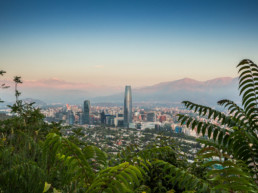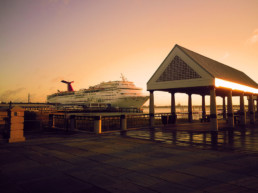Central America spans seven countries and over 500,000 KM of mountain ranges, rainforests, and beautiful coastlines. It consists of Belize, Guatemala, El Salvador, Honduras, Nicaragua, Costa Rica, and Panama. As these developing countries emerge, so does the chance for tourism and exploration.
Over the last few years, I’ve traveled through most of Central America (Belize being the exception), and I’ve had to cross borders using nearly every available method – car, bus, plane, boat, and on foot. While the process is normally straightforward, knowing the best options to get from one country to another can save you a tremendous amount of time, money, and hassle.
Documents
Central American countries do not require prearranged visas from European, North American, or Australian tourists. This will give you 30 days in some countries, and 90 in others. If you are not from these countries, be sure to check your visa requirements before going as they may vary between each country. One important note, however, is that many of these countries require an exit fee anywhere from $10 USD to $50 USD that is only payable in cash, so make sure to save some cash for your departure.
Transportation
Choosing the best method of transportation all depends on how far you want to travel. It’s important to consider that although the distance may not be all that far, the time it takes on some rough roads can be overwhelming. Recently, when traveling from El Salvador to Costa Rica, roughly the same distance as Boston to Washington D.C. (a 720 KM trip done in 8 hours or less), I opted to fly because the bus would have taken me 18 hours and would have required an overnight stop in Managua. After considering lost time, hotel prices, and meals, the flight via Taca Airlines costs me nearly the same.
Taking the bus
For simply jumping from one country to the next, buses are definitely a good option. Ticabus provides quality service through most of Central America and has been my transportation of choice. When crossing borders on a bus, the process is normally very simple. The bus will stop just before the border, allowing the passengers to exit (take your valuables with you) and go through customs. After you get your visa and are approved to enter the country, you then walk across the border and meet your bus again on the other side. This whole process normally takes anywhere from 20 minutes to an hour and is usually accompanied with a resting period afterwards, depending on what time of day you cross. Only once did this vary for me. When crossing from El Salvador to Guatemala, an agent actually entered the bus, stamped our passports, and we were on our way. I don’t believe that is typical, however.
Renting a car
Another option is via rental car. Now, renting a car in Latin America is a whole other process and something to be carefully considered. If you do decide to rent a car and cross the border, make sure to get all the required documents from the rental agency before departing. Some other factors to remember are that borders are businesses, and they do have office hours (I experienced this first hand). So, come 5:00, you may find yourself parked outside for the night. During the rainy season (June to November), some crossings may be closed due to poor road conditions or flooding, so crossing at the larger border crossing may be the best option option. Finally, be aware of what is in your car and be ready to have it searched. They won’t search all vehicles, but if they decide to, they can be very thorough. Finally, don’t be afraid to ask for help. Some smaller border posts lack both organization and instructions which can be frustrating and at times quite confusing. Putting aside your pride and asking if someone speaks English can definitely save you some time in case you run into problems.
Walking
The last option, and probably the most popular amongst us backpackers, is simply walking across borders. It’s simple enough to catch domestic buses to any border, which will drop you off within walking distance of the crossing point (check out www.thebusschedule.com). In these cases, I find it important to brush up on your Spanish vocabulary to make things easier. When walking across a border, you may need get a stamp here, a slip of paper there, and a bag search somewhere else, all with a lack of signage or a specific order. I once spent nearly an hour at the Nicaragua – Costa Rica border trying to find the right offices before finding out that I had to walk back into Nicaragua because I had missed the departure tax office on my way out.
Once you do cross into a new country, don’t get stressed over trying to get to your final destination if there’s not a direct bus from the border. Instead, take a local bus into the nearest city / large town and get transportation sorted out from there. Many times, the borders may only have one or two buses a day into the capitals, but dozens of buses into the closer cities which act as local transport hubs.
Safety and Awareness
Like anywhere else in the world, Central America has its dangers and there are some precautions that you can take to avoid risky situations. Here are a few pointers that may help you while crossing from one country to another.
Avoid taxis
I know this may seem like a paranoia and a huge hindrance, but after a certain number of shady experiences and unjust rates, I have quit using taxis altogether in Latin America. If you do decide to take a taxi, do not be afraid to get out if you are uncomfortable, and never let anyone else split a fare with you.
Watch your bags
This may seem obvious, but it is important to remember that in Central America, spotting a traveler is much easier than in most parts of the world. Even in buses, I always carry my bags up top with me and even then I use a lock to secure the bag to the bus. I’ve seen people walk off of buses with bags just to learn later that it belonged to the person who fell asleep in the back.
Don’t get “assistance” to cross the border
Many times, when someone wearing a backpack crosses the border, they are approached by people saying that they are “guides” or that they can simply help you across. This is true. However, when you get your visa, they may tell you that the stamp is $50 when in reality it is only $10. Or, in a worse scenario, once you hand them your documents, they may ask for money for you to get them back. I’ve heard both good and bad stories of having someone help you through the confusing part of the process to speed things up, so it is for you to decide. However, if you decide to do so, agree on a price beforehand ($5 – $10 is plenty), and only follow them from station to station. Never give them your documents, even just to hand across the counter.
Exchange money later
Although not a safety issue, it is worth mentioning. Once you cross, there are plenty of people standing around offering to exchange your money. If you really need to, exchange a small amount here. Remember though, that is how these guys make money, so their rates are going to be far from true. Save the larger exchanges until you can find a bank or exchange counter.
Central America has some amazing things to offer its tourists. With plenty of untouched territory, those willing to get off the beaten path and explore will be thrilled with what they can find. In a short amount of time, one can experience the aspects that each country offers along with its unique environment and culture. I encourage you to see for yourself the beauty of this area and experience some of the best beaches and rainforests
Make your next trip the best one.
Departful is a full service travel agency creating truly exceptional travel experiences that are 100% personalized to you. Wherever you’re going, whatever your interests, we help you plan the perfect trip.
Seth Mason
Seth currently lives in Raleigh, North Carolina working in hospitality management. He has lived in El Salvador, Costa Rica, France, and South Korea. He lives by the motto "Work hard, play harder" and will take advantage of any time off to get out and notch another place off his list. Some of the things Seth enjoys most in life include soccer, languages, coffee shops, heights, perfectly cooked steak, and waking up to the sound of the ocean. When he grows up he plans to pursue his dream of opening a boutique hotel somewhere in the world.




